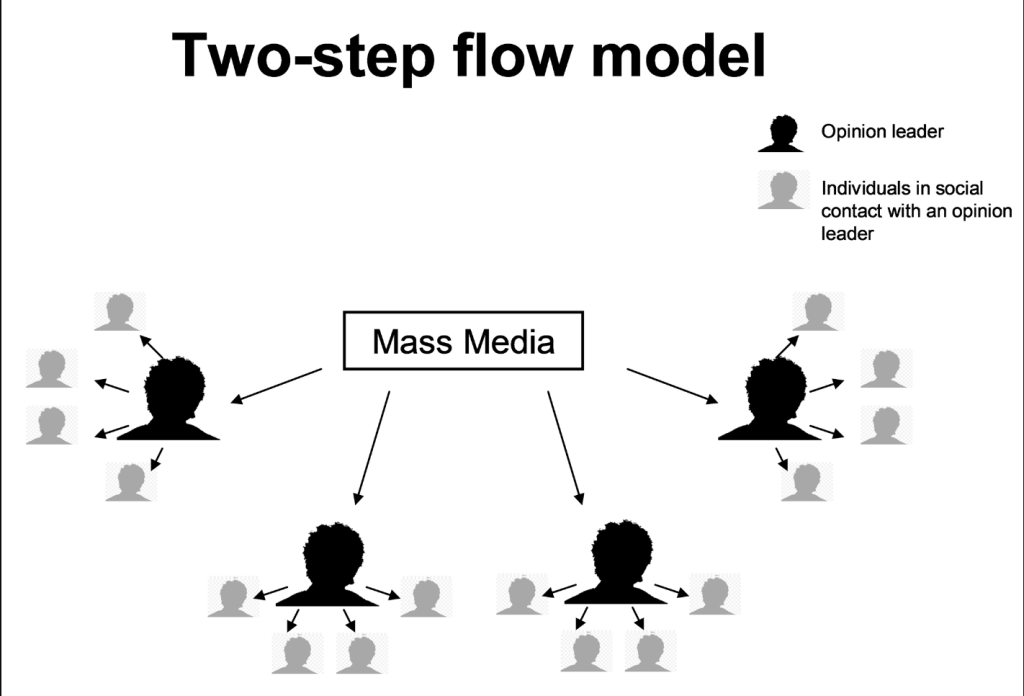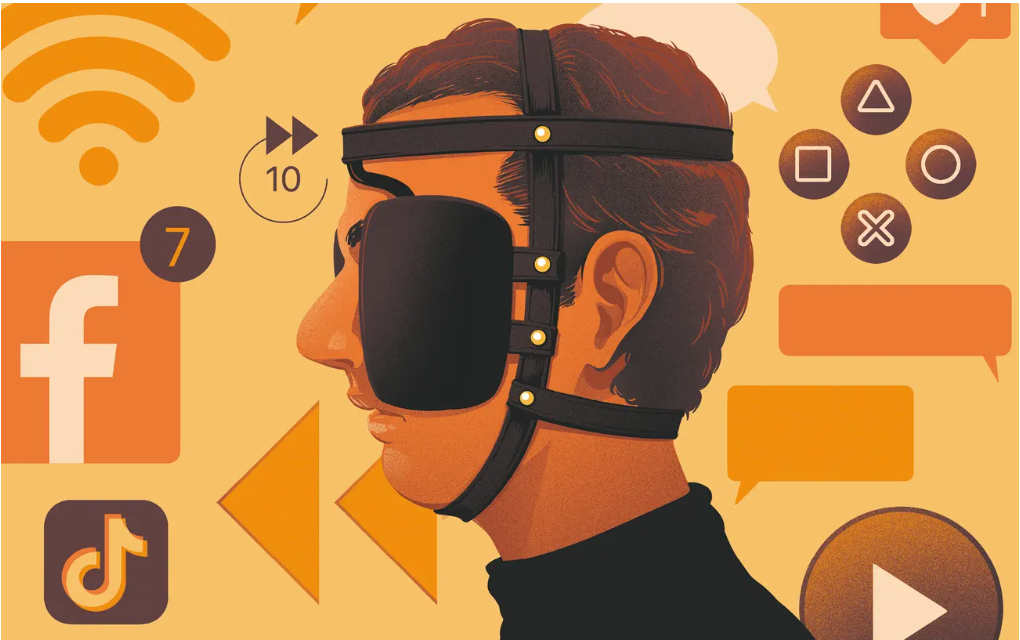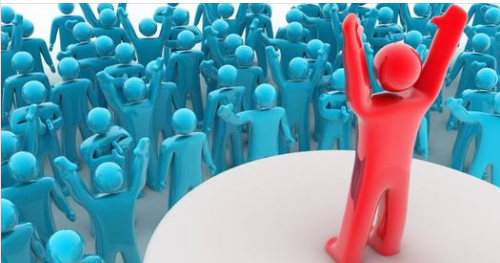With today’s technology being so advanced, social media has become an integral part of people’s lives and basically everyone uses social media. According to the detailed data report, as of April 2023, 9,561 million people worldwide use social media, which is equivalent to 4.2023% of the total global population (2023) . Because of this, mass media directly affects everyone and influences people’s opinions and attitudes. However, the “two-step flow” theory goes deeper by stating that the mass media first influences leaders or opinionated elites.
● What is “ Two Step Flow Theory ”?

The two-step flow theory, a theory developed by Paul Lazarsfeld, Bernard Berelson, and Hazel Gaudet in their book The People’s Choice after studying voter decision-making during presidential elections in the 1940s, argues that the mass media does not directly influence everyone, but first influences opinion leaders or the “opinion elites.” These opinion leaders are well-informed, socially active and respected in their communities. They consume and interpret mass media content and then share their insights and opinions with less active media consumers in social networks.
● Direct impact and limitations of the mass media

When a major news event occurs, such as a natural crisis, a political election or the spread of a virus, the extensive reach of the mass media can have a direct impact on individuals, with the dissemination of the event as well as its coverage through a wide range of mass media software, and media coverage providing information about the event, safety guidelines, election results and updates on the extent of the crisis. This information can have a direct impact on the decisions and actions of individuals, for example, people helping each other in natural disaster situations inspires humanity and empathy, and therefore inspires more volunteers to come forward to help those in the midst of the disaster.

Although the mass media can have a positive impact on individuals, there are some limitations, as the level of acceptance and understanding of information may vary between individuals who receive the information, and these may be related to factors such as age, education, values, social background, emotions, etc., which may have different impacts on individuals. For example, when people are in a state of heightened emotion, they may be more receptive to messages that resonate with their emotions, whereas in a different emotional state, they may react differently or even be averse to the same message. A more obvious example is that a TV series may be popular among the older generation, but it is not popular among the younger group, and this age difference reflects the different enjoyment of culture and media by the age group to which the individual belongs, thus demonstrating the limitations of the direct influence of mass media on each individual.
● The role of “opinion leaders”

Opinion leaders are individuals who have authority and influence in society, they may have in-depth expertise in their field, they may have extensive contacts and social influence in social media, or perhaps they have honest and trustworthy moral qualities, and so on. So they can use their expertise to understand and explain information more thoroughly, they can be active on social media and interact with different social groups to reach a wider audience, and they can use their credibility to become a reliable source of information that others can rely on!
An example is the just-passed outbreak Covid-19, in which doctors and medical experts are often viewed as opinion leaders on health information, and the treatment and prevention of outbreaks is carried out through the statements they make. When doctors advised people to wear masks and stay out as much as possible to minimize infections, people in outbreak settings followed their advice because of their professional knowledge and insights in the medical field and their credibility was unquestionable.
● Summary
To summarize, in some cases the mass media can disseminate information directly to individuals, however, different individuals may react to and understand the same media message in different ways. Therefore, there is a balance between the Two-Step Flow theory and the direct influence of mass media that emphasizes the critical role of opinion leaders in the dissemination of information, while also recognizing the variability of different individuals. These discussions help us to better understand how mass media influences society and individuals, and why people rely on the views of opinion leaders in their information acquisition and decision-making processes.
Reference
https://datareportal.com/social-media-users Kepios,2023
https://www.britannica.com/topic/ two-step-flow-model-of-communication Posteinicu,M
https://www.nimcj.org/blog-detail/ how-mass-media-influence-our-society.html National Institute of Mass Communication & Journalism, Ahmedabad


I like your blog, you show some data, good choice of images, clear headings and give some examples to further explain your topic, analysing the impact of media on humans and using relevant Reference links.
Hi, Gengchen
I think your blog does a great job of capturing the essence of the Two-Step Process Theory and its relevance. With the amount of content flooding our social media feeds, it’s intriguing to see how we still look to opinion leaders to filter and interpret this information.
I think the point about the limitations of the mass media’s direct influence is particularly salient. It reminds us that despite the ubiquity of information, opinion leaders have personalities and background knowledge that cannot be replicated by algorithms or broadcasting. Their influence not only shapes public opinion but also the questions we ask and the dialogue we find worth having.
The COVID-19 incident and the role of medical experts in the outbreak a vivid examples of the role of opinion leaders. For me, it was during this period that theories proved to be the most concrete; the voice of science became the trusted intermediary between raw data and lay understanding.
This blog suggests a relationship between media immediacy and opinion leadership. In a world where everyone has to navigate a sea of overwhelming information, the human touch provided by opinion leaders is not only necessary but indispensable for perceptual awareness and decision-making. You do a great job of highlighting this subtle but powerful interplay.
QAQ
This was a great post Gengchen!
Along with offering a clear explanation of the two-step flow theory for those who might not understand it, your blog discusses and breaks down the different aspects of the theory. The section you wrote about opinion leaders is my personal favourite. Their position is clearly and concisely summarised in the paragraph. I also like the way you expanded on the concept of opinion leaders by using the COVID-19 example. I believe it is important to give an example, as when an example is applied for me it makes a concept easier to understand.
At the start of your post, you mentioned the growth of social media which is very true. Social media is making information more accessible at a much faster rate for people first-hand. In your opinion do you believe this growth will soon overpower the need for opinion leaders distributing information?
Thank you for your comments and compliments. For this question I think the relationship between social media and opinion leaders is complementary. In the article it is mentioned that social media provides a wide range of information sources, but there are also real and fictitious information, people need to consider the authenticity and credibility of the information, and still need to use their professional knowledge and experience to help people sift through the information, which most of the social media users don’t have, and this is when the opinion leaders become especially important. All in all, social media provides a faster channel to disseminate information, opinion leaders help people to explain and filter unknown information, the two complement each other and will not be completely replaced.